In Japan, when you arrive at just about any house, apartment, some businesses, some schools, some restaurants and on and on… you will step into an area called the genkan. The genkan is the entryway of a structure where you will take off your shoes and leave them before moving further into the house, building or wherever it is that you have arrived. When it is required, taking your shoes off in the genkan is a pretty strict rule.
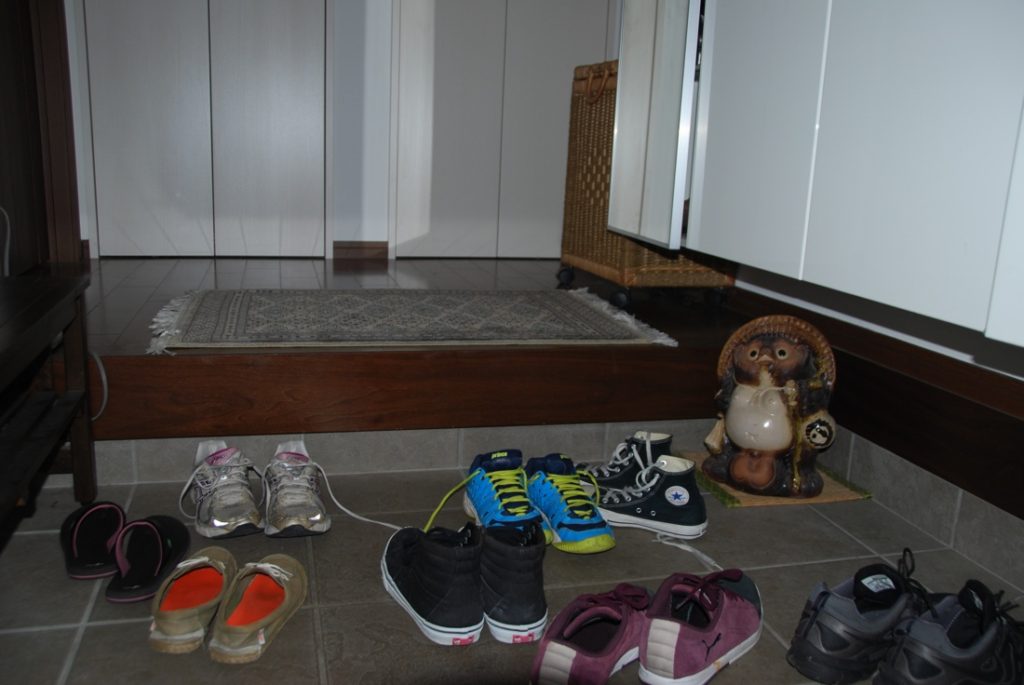 Here is an explanation of genkan from Wikipedia:
Here is an explanation of genkan from Wikipedia:
–The primary function of genkan is for the removal of shoes before entering the main part of the house or building. Genkan are often recessed into the floor, to contain any dirt that is tracked in from the outside (as in a mud room). The tiled or concrete genkan floor is called tataki (三和土).
–Upon entry, shoes are usually turned to face the door so they can be slipped on easily when leaving or placed into a getabako. (A getabako is a shoe cupboard, shoe shelf or shoe locker. See part of our getabako below.) After removing shoes, one must avoid stepping in the genkan in socks or with bare feet, to avoid bringing dirt into the house. Once inside, generally one will change into slippers, or shoes intended for indoor wear (uwabaki).
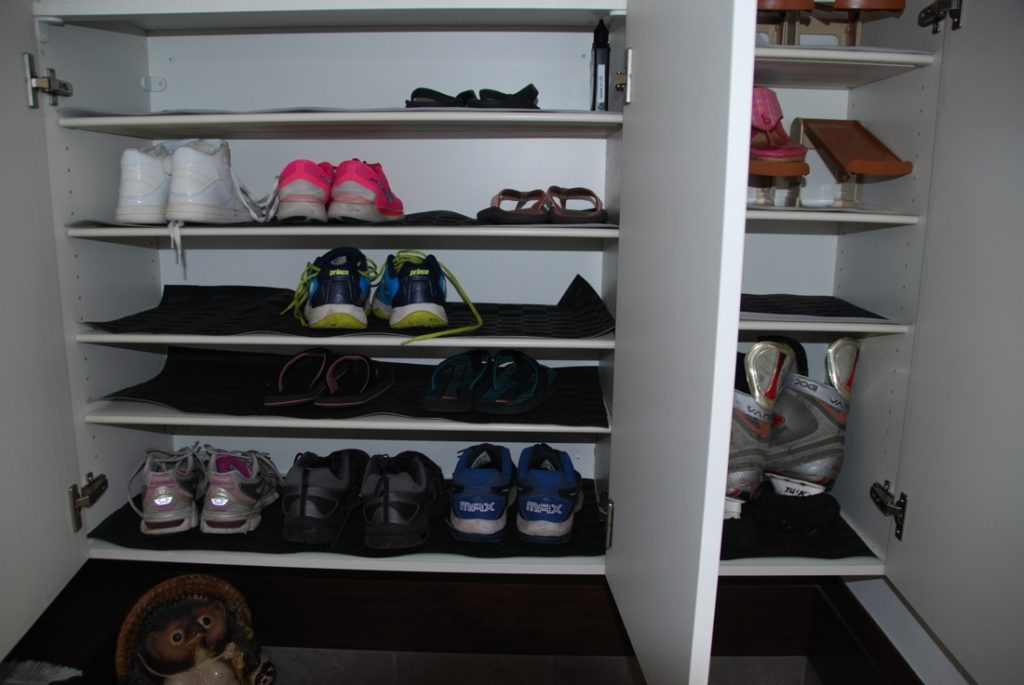
Upon reading this, I realize that already we’re likely breaking some of these shoe rules on a daily basis. We DO take off our shoes before entering the house. But we only sometimes turn them around to face the door, we sometimes step into the genkan with socks or bare feet, and we don’t use house slippers (uwabaki). Probably because we aren’t very organized and because as Americans from California we can’t be bothered to wear slippers when we walk around at home in bare feet everyday, everywhere. Most days in the summer, bare feet ARE our shoes.
Actually the other day we took the kids to water polo practice by car and Halyard did not wear shoes, at all. Thus, during their break he could not go out and get lunch with us. The other parents at the pool could not believe he didn’t wear shoes when he left the house. I tried to explain that in California we might walk around barefoot all day, especially at the pool. One parent said, what if he has to get on the train?
We’re doing our best here with the shoe rules, but like the trash, it gets cumbersome. Before school is probably the most difficult time to follow the no shoes inside the house rule. This is because my kids often forget things after they’ve put their shoes on. In Halyard and Avalon’s case it takes them forever to tie their laces up! So the last thing you want is to have to take shoes off again, especially if you’re already running late. Most of the time the 2 of them will call out to anyone who hasn’t put their shoes on yet to go get something for them upstairs. But if they can’t get anyone to do their bidding for them, they’re stuck. So Halyard and Avalon both have been known to crawl around on the floor on their knees, inside the house with their shoes on, crawling upstairs and crawling around downstairs, so as not to take off their shoes and not to be actually walking in them inside the house. It’s ridiculous!
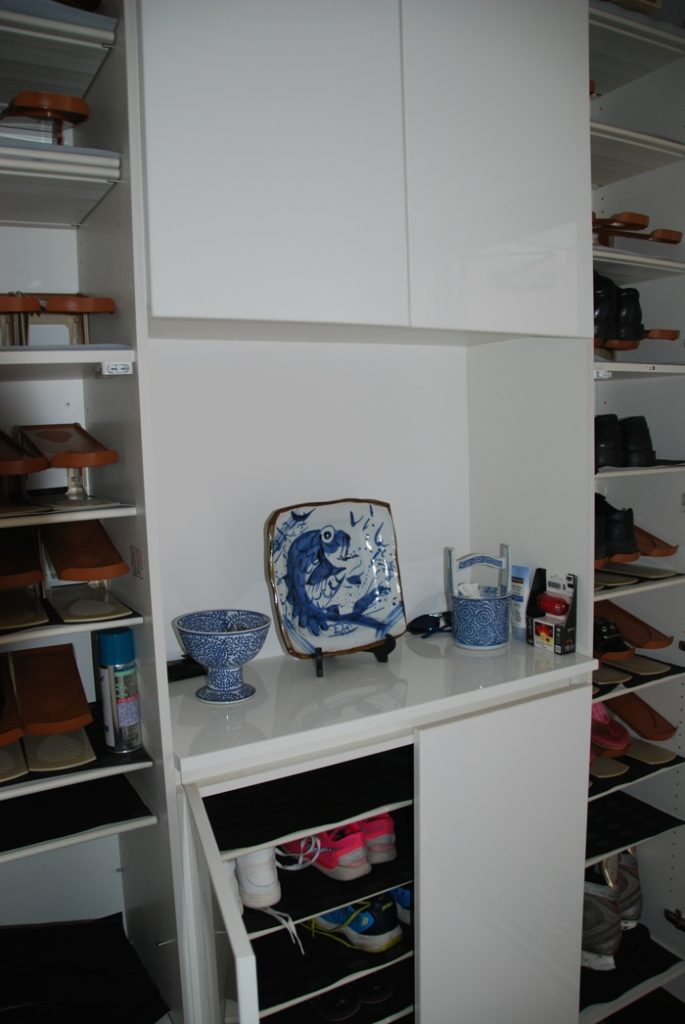 The getabako in our genkan is huge. It’s hard to tell in the photo but our getabako is almost floor to ceiling in the two side cupboards. Imelda Marcos would have plenty of room for shoes in our getabako. Plus, several closets in this house have extra shoe organizers.
The getabako in our genkan is huge. It’s hard to tell in the photo but our getabako is almost floor to ceiling in the two side cupboards. Imelda Marcos would have plenty of room for shoes in our getabako. Plus, several closets in this house have extra shoe organizers.
The genkan at the international school is the huge open lobby area. You don’t actually have to take your shoes off there but it’s called the genkan anyway. Sometimes when I’ve run in there in a hurry my brain has to process whether or not I’m supposed to take my shoes off and I get in a panic over whether I’m going to get busted for having shoes on in the genkan.
Getabako at the swimming pool Getabako at Minoh International Church
Every sports club that we’ve checked out with the kids has had a getabako. When you arrive at the tennis club, the swim club, the gymnastics club, karate dojo… you must take off your shoes outside and place them in the getabako. In the case of tennis, which is of course played with shoes on, you must bring your own indoor-only shoes to play in. At the kids’ school, before you step into the gym for PE you must have your indoor-only (uwabaki) shoes on instead of your sotogutsu (street shoes) on.
Japanese people also use something they call toilet slippers. These are special slippers that are only used in the toilet room. They stay in the WC and are not allowed out. On our first visit to Japan, John was known to forget he was wearing the toilet slippers and proceed to wear them around the house, and even around the bed and breakfast that we stayed at. Eeeewwww. Here’s a scenario: Let’s say you are wearing your house slippers and you have to use the toilet. You must take off your house slippers outside the toilet room door and put on the toilet slippers. Then when you are finished you must take off the toilet slippers, ideally turning them around so the next person can slip right into them, and put your house slippers back on.
One of our American friends here told us they just break out the toilet slippers when guests come over. Sounds like a very good plan to me. John likes to put them on, but then he forgets and walks out of the toilet with them!
Now for a funny shoe story. Some readers may already know this one. We came to Japan in August 2013 for a 3 week vacation. You could say we loved it so much we moved here.
Part of our vacation included a trip to Kyoto. We rented a house and stayed in Kyoto for one week. Before we left the US, I had gone to the travel counter at Mitsuwa in Costa Mesa to book a few tours in various places in Japan. One was an evening tour of the Gion District in Kyoto that included a taxi service, English speaking guide, a theater performance, a walking tour around the Gion District, dinner and a tea ceremony. Our dinner was a traditional, vegetarian shōjin ryōri (devotion cuisine), made by Buddhist Monks. Even the kids ate it (some of it).
There were a dozen or so of us, from all over the world, on the tour. The evening concluded with the dinner and tea ceremony. As we entered the Buddhist enclave we were asked to leave our shoes in the genkan. We all lined them up under a bench. We then walked around in slippers that they gave us. We ate dinner and then our family went on our own to a special private tea ceremony with a geisha apprentice. When it was over, we went back to the genkan, put on our shoes and the taxi was waiting for us to take us home. After Kyoto we traveled to our next destination: a ryokan (traditional Japanese inn) in Hakone, a resort town full of onsen (hot springs) near Mt. Fuji.
We had been in Hakone for a day when I received an e-mail from the travel agency in Costa Mesa. An Italian man on our Kyoto tour said he was missing his shoes and he thought maybe John had taken them by mistake. I said to John, do you have someone else’s shoes??? He said, no. That’s ridiculous, right? I decided to go to the ryokan’s getabako to check out the shoes. I looked at them. They looked like the shoes that I had bought John right before we left for Japan. Black Nike sneakers. I wrote back to our travel agent in Costa Mesa: No, we did not have someone else’s shoes. Sorry!
Later in the day, I thought about it some more. Were they John’s shoes? I looked at them again. Maybe not. Maybe he DID have someone else’s shoes. They looked so similar but I had just bought them before we left so maybe… I wrote back to the travel agent in Costa Mesa. Maybe John had put on some other man’s shoes and didn’t notice they were the wrong shoes! Yes, he did. After that we had a lot of e-mail exchanges (between the Costa Mesa and Italian travel agencies) trying to figure out the best way to switch our shoes back. The Italian man had John’s shoes because when he was stuck in Kyoto he had no other shoes to wear except for the wrong ones!
The Italian man said that the reason he really wanted his shoes back was because they had a special, custom orthopedic insert which was quite expensive. Really! John didn’t even notice I guess. But the family was already back in Italy. Our agent in Costa Mesa tried to contact their agent in Italy for their address. It was difficult and time consuming. Finally, the Italian travel agent said to mail the shoes back to Italy to their agency and they would be sure to get them back to the family.
For the rest of our vacation in Japan it became a running joke that John could now go looking for a better pair of shoes. Don’t like your shoes? Just find a new pair at the temple! Lots of fun shoes to pick from all over Japan!
When we got home I mailed the shoes back to Italy with a letter of apology. I included our e-mail address so the Italian man could contact us directly. It cost a small fortune to mail a shoebox to Italy! It was now around mid-September by the time we got all this taken care of. After a while we received an e-mail from the Italian family. They were so surprised to get their shoes back! They said they left John’s shoes in their summer home in Rome and they were now back at their main home in Milan. They promised to send John’s shoes back the next summer when they were back in Rome. I explained that John’s shoes were brand new when we went to Japan and that’s why John didn’t even recognize that he had the wrong shoes on! I think they appreciated the explanation as they were quite baffled as to why anyone wouldn’t notice they had the wrong shoes, especially ones with an orthopedic insert!
In the summer of 2014 we received a box from Rome, Italy with John’s shoes! I think they might even be in Japan with us now. He hardly ever wears them so maybe they made their way back.
John’s black Nike sneakers have been all over the world and back again.
Right when we arrived I realized that Halyard needs new shoes. It is hard to find large sized shoes here. Japanese feet must max out around men’s size 9/10, or 27 cm. It has been challenging to find shoes that fit Halyard and John, and equally hard, socks have been like a treasure hunt too! At Uniqlo, every one of their 100 colors of socks seem to all be the same small size.
Thank you Tessa and Kate for giving Avalon shoes to bring to Japan. She is enjoying them. She needed a pair of uwabaki (indoor shoes) for PE in the gym so we washed a pair of sneakers and they looked perfectly new again!
I’ve heard that it’s going to be very cold here in winter and we need to get some warm winter shoes. And warm winter socks. No more bare feet.
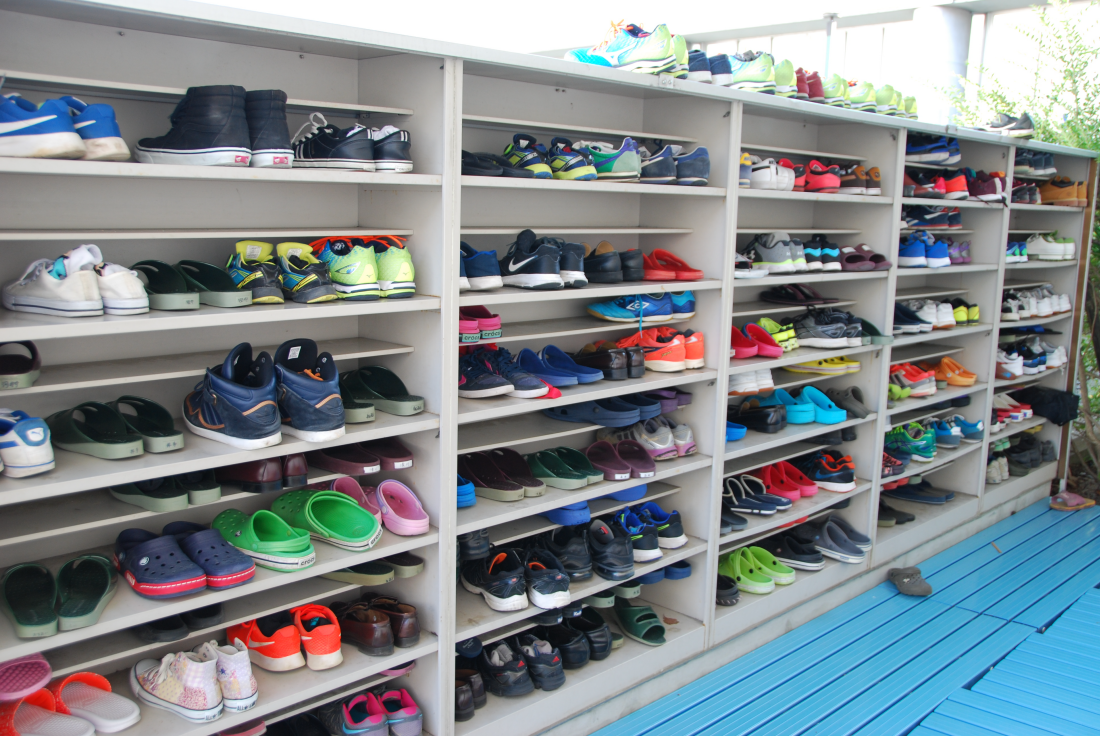

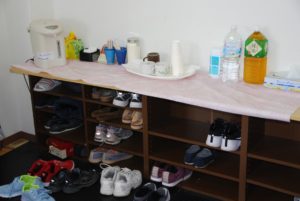

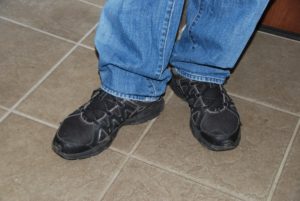
Comments (2)